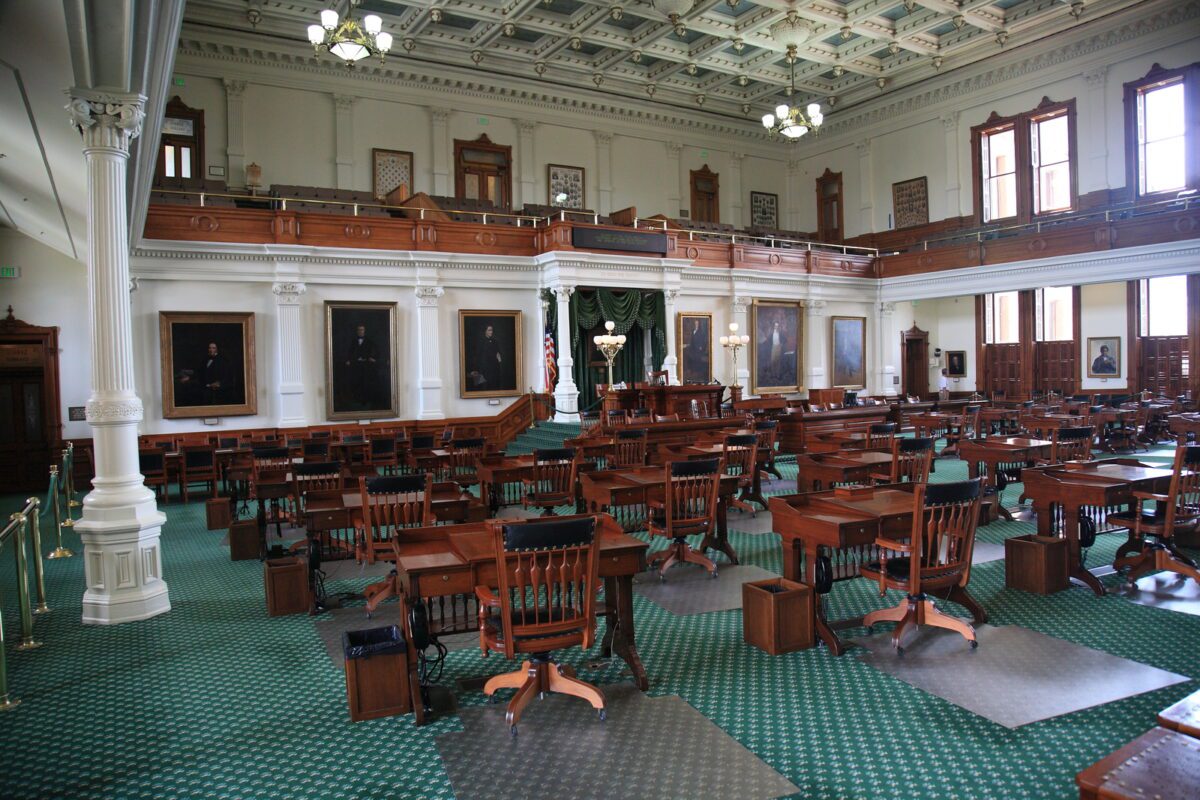Share the post "Type of Government Texas Has (Unitary Democratic)"
Although the United States has a President and Government, each state in the U.S. has its own Government and Governors. The Governor and State Governments acknowledge and adhere to a Presidential Government and have their own state branches.
They set legislation and manage their affairs in line with what is best for the state’s citizens.
Texas is a unitary democratic state with a constitution. A Governor is the Head of State, and the government has 3 branches; the Executive comprises 6 members, the Legislative, and the Judiciary. The Legislature passes laws, the Executive imposes laws, and the Judiciary interprets the law.

Texas Is Self-Governed But Respects The Presidential System
Texas is a unitary democratic state that subscribes to the Dillion Rule and is regulated by the Constitution of Texas. Texas, as an American state, is ultimately governed by a presidential system; a government with a president as head of government.
Separation of powers is the cornerstone of a unitary democratic state, in which three branches oversee different aspects of government and hold each other accountable.
- The Legislature passes laws.
- The Executive imposes the laws.
- The Judiciary interprets these laws.
Over-and-above each branch’s specific role, and the Executive has the authority to issue Executive orders or decrees.

Dillion Rule Applies In Texas But With Certain Exceptions
For the most part, Texas has adopted the Dillion rule, but certain cities are granted Home Rule status. The Dillion Rule effectively means that the cities and municipalities may only exercise authority if the state has conferred it.
Home Rule, on the other, allows self-governance, and municipalities may create rules and make decisions as they deem fit. Although home rule gives municipalities a degree of autonomy, they may not contravene state legislation.
In Texas, cities with more than 5000 residents may exercise home rule, and the state has limited influence over the decisions and policies of the local municipality. General law applies to cities with less than 5000 residents, and the state presides over their activities.

Texas Has A Constitution
The Texan Constitution outlines important issues about how Texas is governed. The Constitution sets these out in detail and covers the following sections:
- Bill of Rights
- Powers of Government
- Legislative Department
- Executive Department
- Judicial Department
- Suffrage
- Education
- Taxation and Revenue
- Counties
- Railroads
- Municipal Corporations
- Private Corporations
- Spanish and Mexican Land Titles
- Public Lands and Land Office
- Impeachment
- General Provisions
- Mode of Amending the Constitution of The State

The Bill Of Rights Is First And Foremost
An important aspect of governing is the rights of citizens. The Constitution establishes the rights as a precursor to the powers of government, and the Texan Government is structured to uphold the Bill of Rights. No law or action by the Texan Government may infringe on these rights.
The Bill of Rights provides clear instructions regarding Texas citizens’ rights and covers each right in detail.
Sections 1 – 3 Clarify The Context In Which Texas Is Governed
Although there are 17 sections in the Bill of Rights, sections 1 – 3 form the basis on which the State of Texas is governed.
- Section. 1. – Addresses Freedom and Sovereignty of State, confirming that Texas is an independent state that complies with the Constitution of the United States, which guarantees the rights of Local Government to freely govern, in this instance, the State of Texas.
- Section. 2. – Refers directly to Texas’ commitment to a Republican Government, elected by the state’s citizens and put in place for the benefit of Texan residents.
- Section. 3. – Confirms that all men are equal and have the same rights. No one is above the law or has special privileges.

The Constitution Outlines Structure And Power Of Government
The Texan Government’s structure emulates the United States Government and comprises three independent branches. Each branch works with the others to uphold the Bill of Rights and govern Texas in the best interests of its people. The advantage of this structure is that no one has unfettered power.
The Governor Has Constitutional And Statutory Responsibilities
The Governor is the Head of State in Texas and a member of the Executive Branch. Texan Governors are elected by Texan citizens every 4-years. The Governor’s responsibilities are:
- Taking up the role of Commander in Chief of the state’s military
- Making appointments of candidates for all the departments that carry out laws and create policies
- Declaring and enforcing special elections to fill vacancies in elected offices.
- Calling special Legislature sittings for critical matters that cannot wait until the next legislative session.
- Signing and recommending bills.
- Vetoing bills
- Providing a report on the condition of the state of Texas to the Legislature at the start of each sitting.
- Providing a statement of account for all public money paid out by him.
- Creating a budget for the state and estimating the taxes required to facilitate the budget.
- Granting pardons and reprieves for prisoners following recommendations by the Board of Pardons and Paroles.
The Texan Government Is Divided Into Three Departments
Texas complies with the separation of power principle stipulated in its Constitution. Separation of Powers guarantees a more regulated and accountable government. The three Departments are the Executive, the Legislative, and the Judicial Departments.
No member of each of these departments may interfere with or influence another department.
The Executive Comprises 6 Key Positions
Although the Governor is Head of State, his role is not autonomous, and other members of the Executive have extensive responsibility in governing Texas. Members of the Executive are elected by popular vote.
The only member not voted in by Texas is the Secretary of State. The key positions in the Executive are:
- The Lieutenant Governor establishes committees and decides parliamentary procedure in the Texas Government.
- The Governor appoints the State Secretary, responsible for publishing rules and regulations and verifying the Governor’s signature on all official documents.
- The Comptroller of Public Accounts is the Chief Financial Officer and is responsible for all financial dealings in the State of Texas.
- The Commissioner of the General Land Office chairs several state boards and manages mineral rights, state assets, and investments by the state.
- The Attorney General’s function is to defend the Constitution and the laws of Texas.

The Senate And House Of Representatives Are The Legislature
The Senate and House of Representatives make rules and laws to benefit the citizens of Texas. Any rule must be ratified by the Senate and House of Representatives before it passes to the Governor for signature. The Senate has 31 members, and the House of Representatives has 150.
Texas is divided into Senatorial Districts, and each district elects a Senator by a general election. Each Senator serves about 811,000 Texas citizens and serves a 4-year term. The role of a Senator is to find solutions and propose and write laws to better the lives of Texans.
Census information is used to ensure that each citizen of Texas has an equal opportunity to be represented in both the Senate and House of Representatives.
Senators meet every 2nd year for a session that lasts 140 days. This is known as the regular session. Suppose any urgent matters arise outside of the regular session. In that case, Governors have the right to call a special session limited to 30 consecutive days.
The House of Representatives is elected across various counties. Members of the House of Representatives represent counties based on population statistics. Suppose a county needs more residents to meet the requirements for representation.
That county is combined with another to make up the numbers.
The Judiciary Presides Over All Aspects Of Law In Texas
The Judiciary Branch interprets the laws and Constitution of Texas, upholds the Bill of Rights, and resolves legal issues. The Board of Texas Judiciary comprises of:
- Presiding Judges advise local judges, implement regional rules and recommend changes to the Supreme Court.
- Chief Justice of the Supreme Court hears matters not resolved in the courts of appeal.
- Chief Justices of the Courts of Appeal reviews decisions made in trial courts to determine whether they were legally sound and fair.
- Judges of the Trial Courts, depending on which court they preside over, hear cases, administer cases and decide on sentencing or fines to be imposed.
All aspects of law and legal disputes are administered and processed through the various courts of law in the State of Texas. The courts are designated power and assigned responsibilities but may not contradict the Constitution or the rights of Texan Citizens. The courts are structured as follows:
- The Supreme Court administers the Texan Judicial System.
- A Court of Appeals hears previously heard cases and the judgments disputed.
- District Courts preside over felony criminal cases, divorce cases, and civil cases.
- County Courts rule on misdemeanors that are not as serious as felony cases.
- Commissioners’ Courts are responsible for ruling on budgets and policies in county government.
- Courts of Justices of the Peace make rulings on minor civil matters.
- Municipal Courts rule on issues about contraventions of city regulations.
Texas Has A Grand Jury System
As prescribed in the Bill of Rights, felony cases in Texas must be heard by 12 jurors, and at least 9 jury members must agree to a verdict before it is accepted by the court. A juror’s responsibility is to determine whether there is probable cause that a defendant is guilty of committing a crime.
Texas’ Government FAQs
Where Is The Texas Government Based?
The Texas Government operates from downtown Austin.
Does The Texas Government Have A Sitting For Citizens To Attend?
The Texan Government has open meetings for citizens and provides a handbook detailing the requirements for open meetings. There is also a tool-free Government hotline that citizens can call to learn about their rights and responsibilities. The number is 877-OPEN TEX (877-673-6839).
References:
- Structure of the government: wikipedia.org
- Texan constitution: tlc.texas.gov
- Governor’s role: statutes.capitol.texas.gov
- Roles of the Executive: oertx.highered.texas.gov
Share the post "Type of Government Texas Has (Unitary Democratic)"
Christian Linden is a seasoned writer and contributor at Texas View, specializing in topics that resonate with the Texan community. With over a decade of experience in journalism, Christian brings a wealth of knowledge in local politics, culture, and lifestyle. He holds a Bachelor's degree in Communications from the University of Texas. When he's not writing, Christian enjoys spending weekends traveling across Texas with his family, exploring everything from bustling cities to serene landscapes.











